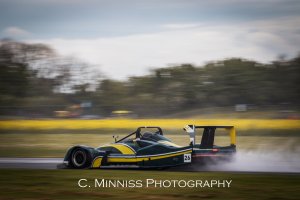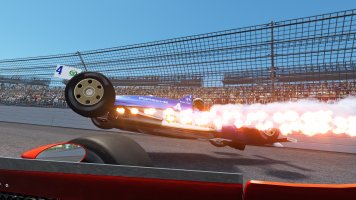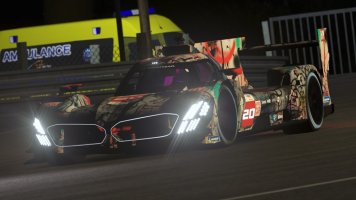Photography at night commands a lot more than the average daytime session. Here's what we do to get some of our favourite shots in sim racing under the cover of darkness!
Photographing cars during the day is hard enough, but have you ever tried to take good-quality photos of race cars at night? Whether in sim or real life, the skillset is entirely separate and can define a photographer's portfolio. An event like this weekend's 24 Hours of Le Mans is the perfect example of an event that requires a few additional skills once the sun sets.
In our recent photography piece on 'Six Simulators to Practise Your Photography', we did not mention the art of night photography. To complete the picture, here are some of the most important things to know before getting stuck into night time shots in your favourite sim!

Assetto Corsa Competizione at night - and in the rain!
A lower ISO value means less sensitivity to light, while a higher ISO means it is more sensitive. Be careful though, too far up the ISO scale and that crucial shot will be overexposed and ruined. The plus side of shooting within sim racing? Just hit rewind and try it again!

#100 Tom Ingram, Thruxton. Image: C. Minniss Photography
Sim racing photo modes are the perfect playground for budding photographers to nail down a rough settings guide for real photography. Getting your ISO right is an essential skill, especially as you cannot shoot in RAW when taking screenshots. RAW files are highly customizable image files that is commonplace for photographers in the real world.

Automobilista 2 at night. Image: Reiza Studios
Although we do not usually have the issue of hardware restricting our photography within sim racing, it is still important to recognise what these sliders do. If you ever decide to take your photos out of the virtual world and into the real one, you are going to need that photography knowledge.
You will isolate your subject in the centre of your frame if you shoot at a much wider aperture, for example, f1.8. If you are shooting a badge or even a glowing brake disc that requires more detail, ensure the background is sufficiently blurry with a low focal length. Having a low focal length is essential to create the effect that many photographers aim for in their photos, both in the sim and reality.

Ford Mondeo, National Bangers. Image: C. Minniss Photography
Using such a slow shutter speed at night can start to produce light trails, although I would recommend using multiple seconds worth of delay in your shutter speed. Headlights, taillights, brake discs and sparks all make great photo subjects at nighttime, especially with your shutter speed dialed in. But what about sim racing?
The shutter speed can often be previewed, which is helpful, depending on which simulator you are shooting in of course. The shutter speed settings within sims are generally fairly accurate. Just be ready to go through a lot of trial and error to find exactly what you want, especially if you are coming from the real world instead of the other way around.
Just remember that if you are photographing a static subject in the pitlane, at the scene of an accident or on the starting grid for example, you have to change your shutter speed accordingly. Make sure to adjust your aperture as well. The photo below was shot at 1/100 shutter speed but would likely have been adjusted upwards at night.

Wrecked Ford Mondeo, National Unlimted Bangers. Image: C.Minniss Photography
These photos are rare, and catching the perfect moment is never easy. For example, a glowing brake disc is difficult, if not impossible, to capture in the daylight. Make sure you make the most of it in sim racing to learn the angles that work the best. I would recommend Assetto Corsa to practise in, simply because you can adjust the time of day whilst still in the session.

GT3 Bentley's front brakes glow in the dark. Image: Kunos Simulazioni
If this guide was at all helpful, let me know in the comments below and make sure to attach your own photos. I cannot wait to see what the OverTake community can produce within sim racing and the real world under the cover of darkness!
Have you tried photographing cars at night? Let us know how you got on over on X @OverTake_gg or down in the comments below!
Photographing cars during the day is hard enough, but have you ever tried to take good-quality photos of race cars at night? Whether in sim or real life, the skillset is entirely separate and can define a photographer's portfolio. An event like this weekend's 24 Hours of Le Mans is the perfect example of an event that requires a few additional skills once the sun sets.
In our recent photography piece on 'Six Simulators to Practise Your Photography', we did not mention the art of night photography. To complete the picture, here are some of the most important things to know before getting stuck into night time shots in your favourite sim!
Assetto Corsa Competizione at night - and in the rain!
Correct Camera Settings
ISO
The settings used for night photography are significantly different to what you would use during the day. If the sun is out, you could be shooting as low as 100iso, depending on your placement in conjunction with the sun. However, if it is dark, you will find that the number is upwards of 3400.A lower ISO value means less sensitivity to light, while a higher ISO means it is more sensitive. Be careful though, too far up the ISO scale and that crucial shot will be overexposed and ruined. The plus side of shooting within sim racing? Just hit rewind and try it again!
#100 Tom Ingram, Thruxton. Image: C. Minniss Photography
Sim racing photo modes are the perfect playground for budding photographers to nail down a rough settings guide for real photography. Getting your ISO right is an essential skill, especially as you cannot shoot in RAW when taking screenshots. RAW files are highly customizable image files that is commonplace for photographers in the real world.
Aperture
The 'Aperture' setting can be a physically moving mechanical piece of the camera, or a digitally-controlled one. This parameter of photography lets in more or less light depending on which lens you are using. These can range from F0.8 up to F32. The F at the start of those numbers detail what the 'Focal length' is.Automobilista 2 at night. Image: Reiza Studios
Although we do not usually have the issue of hardware restricting our photography within sim racing, it is still important to recognise what these sliders do. If you ever decide to take your photos out of the virtual world and into the real one, you are going to need that photography knowledge.
You will isolate your subject in the centre of your frame if you shoot at a much wider aperture, for example, f1.8. If you are shooting a badge or even a glowing brake disc that requires more detail, ensure the background is sufficiently blurry with a low focal length. Having a low focal length is essential to create the effect that many photographers aim for in their photos, both in the sim and reality.
Shutter Speed
When shooting in the real world, I start shooting at 1/100 of a second. This gives me sufficient working space to explore what the framing can do for me and what the lens is capable of keeping in focus with the settings I have. I slowly make my way down the ladder of shutter speeds until I reach around 1/30. When shooting at night, I try to stick to this philosophy the best I can. The shot below was captured with 1/40 shutter speed.Ford Mondeo, National Bangers. Image: C. Minniss Photography
Using such a slow shutter speed at night can start to produce light trails, although I would recommend using multiple seconds worth of delay in your shutter speed. Headlights, taillights, brake discs and sparks all make great photo subjects at nighttime, especially with your shutter speed dialed in. But what about sim racing?
The shutter speed can often be previewed, which is helpful, depending on which simulator you are shooting in of course. The shutter speed settings within sims are generally fairly accurate. Just be ready to go through a lot of trial and error to find exactly what you want, especially if you are coming from the real world instead of the other way around.
Just remember that if you are photographing a static subject in the pitlane, at the scene of an accident or on the starting grid for example, you have to change your shutter speed accordingly. Make sure to adjust your aperture as well. The photo below was shot at 1/100 shutter speed but would likely have been adjusted upwards at night.
Wrecked Ford Mondeo, National Unlimted Bangers. Image: C.Minniss Photography
Look For Things That Are Not Visible In Daylight
The composition of night-based motorsport photography is drastically different to regular photos, even in sim racing. You have to have an eye for things that appear under the cover of darkness that normally do not stand out during the day.These photos are rare, and catching the perfect moment is never easy. For example, a glowing brake disc is difficult, if not impossible, to capture in the daylight. Make sure you make the most of it in sim racing to learn the angles that work the best. I would recommend Assetto Corsa to practise in, simply because you can adjust the time of day whilst still in the session.
GT3 Bentley's front brakes glow in the dark. Image: Kunos Simulazioni
Conclusion
A lot of the included photos are not from night sessions - that is obvious. I have not had the opportunity to shoot any races at night that I am allowed to share photos of publicly. Therefore, writing this piece and practising in sim racing's photo mode has certainly helped prepare me for when I can shoot some more photos in the dark.If this guide was at all helpful, let me know in the comments below and make sure to attach your own photos. I cannot wait to see what the OverTake community can produce within sim racing and the real world under the cover of darkness!
Have you tried photographing cars at night? Let us know how you got on over on X @OverTake_gg or down in the comments below!



